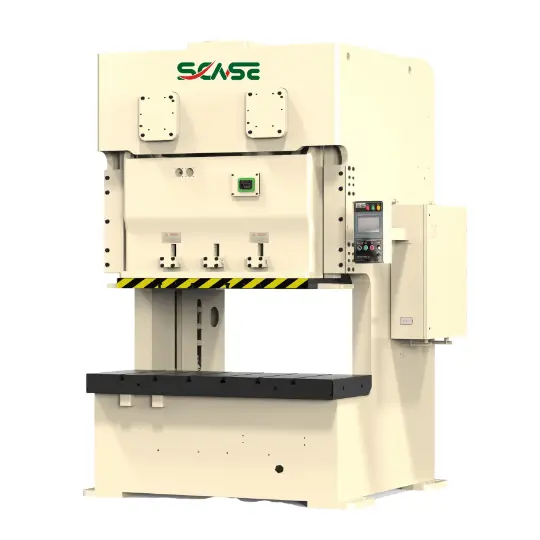Optimizing C Frame Power Press Working Principle
The C frame power press is a versatile machine tool widely used in manufacturing for shaping materials like metal and plastic. At its core, it applies force to reshape metal sheets or profiles using a motor or hydraulic system. The C frame provides stability and a consistent work surface, ensuring precise and accurate operations.
Key Components:
- Ram: Moves up and down to cut or shape the material.
- Table: Where the material sits and the cutting process occurs.
- Guide Bars: Ensure the ram moves smoothly and accurately.
- Hydraulic or Motor System: Provides the necessary force to move the ram.
How It Works:

The C frame press uses a motor or hydraulic system to move the ram, which in turn cuts or shapes the material. The C frame design offers a sturdy and solid base, providing stability and consistent precision throughout the process. This makes it reliable for a wide range of applications.
Enhancing Efficiency and Productivity in C Frame Power Presses
To maximize efficiency, several methods can be employed:
Optimizing Material Feeding
Choosing the right guide bars and adjusting speeds can significantly improve efficiency. Proper setup and regular calibration ensure smooth operation and reduce wear and tear.
Reducing Setup Times
Minimizing changes between materials is crucial. Implementing automation technologies, such as programmable sensors and touchless controls, can further reduce setup times. Case studies show that automation can reduce downtime by up to 30%.
Implementing Digital Controls
Digital controls and sensor systems can enhance precision and speed. These systems can monitor and adjust the cutting process in real-time, leading to higher quality products and faster production times.
Improving Safety and Compliance with C Frame Power Press Standards
Safety is paramount in C frame presses. Adhering to OSHA guidelines is not just a legal requirement; its a commitment to protecting your team and the environment. Here are key steps:
Inspecting Equipment
Regularly inspect equipment for wear and tear to prevent failures. This includes checking guide bars, ram alignment, and hydraulic systems.
Ensuring Operator Training
Proper training ensures operators understand load capacities, how to use protective gear, and safety protocols. This reduces the risk of accidents and enhances overall safety.
Implementing Accident Prevention Measures
Maintain a clean and organized workspace. Use safety guards and interlocks to prevent accidental contact with moving parts. Regular training and drills help prepare teams for emergency situations.
Challenges and Limitations in C Frame Power Press Utilization
While C frame presses are powerful tools, they come with challenges:
Limited Flexibility in Cutting Shapes
Traditional C frame presses are more suited for standard shapes and may require adjustments for irregular parts.
High Initial Costs
The initial setup and purchase cost can be a barrier for small manufacturers. However, long-term benefits often outweigh these initial expenses.
Need for Skilled Operators
Improper use can lead to inaccuracies or damage. Training and regular maintenance are essential to minimize these risks.
Innovations and Technological Advancements in C Frame Power Presses
Recent advancements have significantly improved the performance and versatility of C frame presses:
Advanced Hydraulics
Advanced hydraulic systems provide better control and precision, reducing energy consumption and extending equipment life.
Digital Controls
Digital controls offer real-time monitoring and adjustment, ensuring optimal performance and reducing downtime.
Smart Automation Systems
Automated systems can optimize cutting patterns, improve quality, and enhance overall efficiency. For example, AI-driven systems can predict and adjust for material thickness variations, leading to more consistent outcomes.
Applications and Industries Utilizing C Frame Power Presses
C frame power presses are essential in various industries:
Automotive Industry
Used for sheet metal forming, such as creating body panels and interior components. High precision and efficiency are critical in this sector.
Aerospace
Precision is paramount in crafting parts like wings and engine components. C frame presses help achieve the required accuracy and strength.
Manufacturing Sectors
Versatile in producing a range of shaped parts. Industries benefit from the ability to create lightweight, durable components, making C frame presses a valuable tool.
Case Study: Automotive Industry
A leading automotive manufacturer enhanced productivity by integrating smart automation systems into their C frame presses. This not only improved the quality of parts but also reduced downtime by 30%.
Case Study: Aerospace Industry
An aerospace company used advanced hydraulics and digital controls to achieve high precision in cutting complex parts. This led to a significant improvement in the quality and reliability of their products.
In conclusion, optimizing the C frame power press involves enhancing efficiency, ensuring safety, embracing technological advancements, and expanding applications. By addressing challenges and implementing innovations, manufacturers can achieve higher productivity and quality, driving the future of manufacturing industries.
-
-
-
-
-
-
6.2Aerospace





